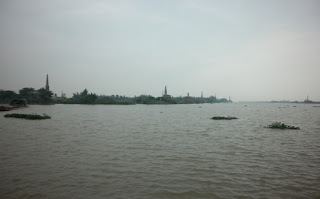A teacher was teaching when the classroom became full of smoke, which made the class unable to continue the lesson. This happens regularly. Moreover, our teacher has a disease in her respiratory system and the smoke makes the matter worse. Now she doesn’t have good health. Therefore, our group decided to go to the field nearby to find out the cause of the smoke. On the way we saw some accidents. It was because of the smoke that the visibility was limited and the motorcyclists could not see the road very well. The surrounding areas were full of moke because farmers were burning straw in the field. We realized how harmful is the burning of straw after harvesting, so we decided to choose this topic: “Some solutions to straw after harvesting to reduce air pollution in agricultural areas”.
Video: Interview
II. Real situation of air pollution as a result of smok
Our research group went to find out the reality in some rice fields and streets in the town nearby as well as took many photographs and made some videos. We saw with our own eyes thick smoke caused by burning straw and its bad effect on people’s lives. We interviewed the people living in surrounding areas. Most of them showed their unpleasant attitude towards straw burning. Dan Phuong district is situated in the suburb of Hanoi
Nowadays, most farmers do not use straw as a kind of fuel in their homes any longer, so they do not bring them home. But in our opinion, the main reason is that farmers do not have much knowledge of the advantages of straw. Moreover, they are not aware of the danger of environment pollution. There have been many scientific researches on straw showing that straw has great economic benefits which are mentioned in the next part. However, farmers are not told about that and they do not know about the very bad situation of current environment pollution. Harmful effects caused by straw burning are much more serious than people think. Gases released in the process of burning straw such as CO and CO2 are harmful to the environment. Moreover, farmers usually burn straw late in the afternoon, which would increase the level of pollution because at that time the temperature falls, the thick atmosphere tends to cover the area. As a result the smoke can not rise. On wet or windless days the smoke from straw burning diffuses slowly, slowing down the circulation of air molecules in the atmosphere and bringing more harm. To sum up, the consequence of straw burning is environment pollution, an increase in greenhouse effect, climate changing and ecologic imbalance.
 |
| Straw burned on the road |
Another harmful effect of straw smoke is that it affects people’s health badly, increasing the diseases related to respiratory system such as lung cancer. Furthermore, traffic accidents happen more often because smoke from straw burning limits the visibility and big burning heaps of straw on the road sometimes block the traffic, which also increase the risk of the burning of other things.
People think that burning straw right in the field can make it good fetilizer. Nevertherless, under high temperature some organic substances in the straw may become useless inorganic substances. Burning straw right in the field also makes the land dry because an amount of water evaporates during this process. Burning straw is a waste of raw materials. Instead of being used properly, it is to blame for many problems.
 |
| A car catching fire from straw burning |
III. Some suggested solutions
In Vietnam, burning straw is a common thing in many provinces such as Ha Noi, Nam Dinh, Thai Binh, Ha Nam, etc. What to do with straw after harvests is also an urgent matter in many agricultural areas in the South East Asia as well as around the world. In the hope to contribute to the improvement of the situation, the research group of Dan Phuong High School Vietnam or in the South East Asia but also in many rice cultivating areas in the world.
1/. The first solution is that we should raise people’s awareness of harmful effects of burning straw as it affects people’s health, contributes to environment pollution and causes many traffic accidents.
 |
| Straw as a material to plant mushrooms |
 |
| Producing fertilizers from straw |
 |
| Producing building materials from straw |
If people can carry out the above solutions, burning straw after harvesting can be reduced. As a result, harmful effects of burning straw on environment and people’s health will certainly decrease. Moreover, when straw is used properly, it can raise people’s income, improve the soil, increase the plant productivity, save fuels and materials.
IV. Conclusion
It is clear that burning straw can lead to many problems. Hoever, knowing how to deal with it brings a lot of benefits. To make the situation better we should make farmers change their awareness and all the people have to take responsibility for solving the environment pollution problems.
Our research group hopes that the above solutions will be popularised not only in Vietnam but also in the South East Asia and throughout the word.
The research is carried out by the representatives of three classes of
Order | Name | Class | Notes |
1 | Nguyễn Hoàng Yến | 11A9 | Leader |
2 | Nguyễn Thị Khánh Ly | 11A9 | |
3 | Dương Ý Như | 11A9 | |
4 | Nguyễn Thị Thu Trang | 11A9 | |
5 | Nguyễn Thị Minh Khuê | 11A9 | |
6 | Nguyễn Hà Thành Luân | 11A2 | |
7 | Nguyễn Huy Hoàng | 11A1 | |
8 | Nguyễn Văn Lâm | 11A1 | |
9 | Trịnh Duy Phương | 11A1 | |
10 | 11A1 |























